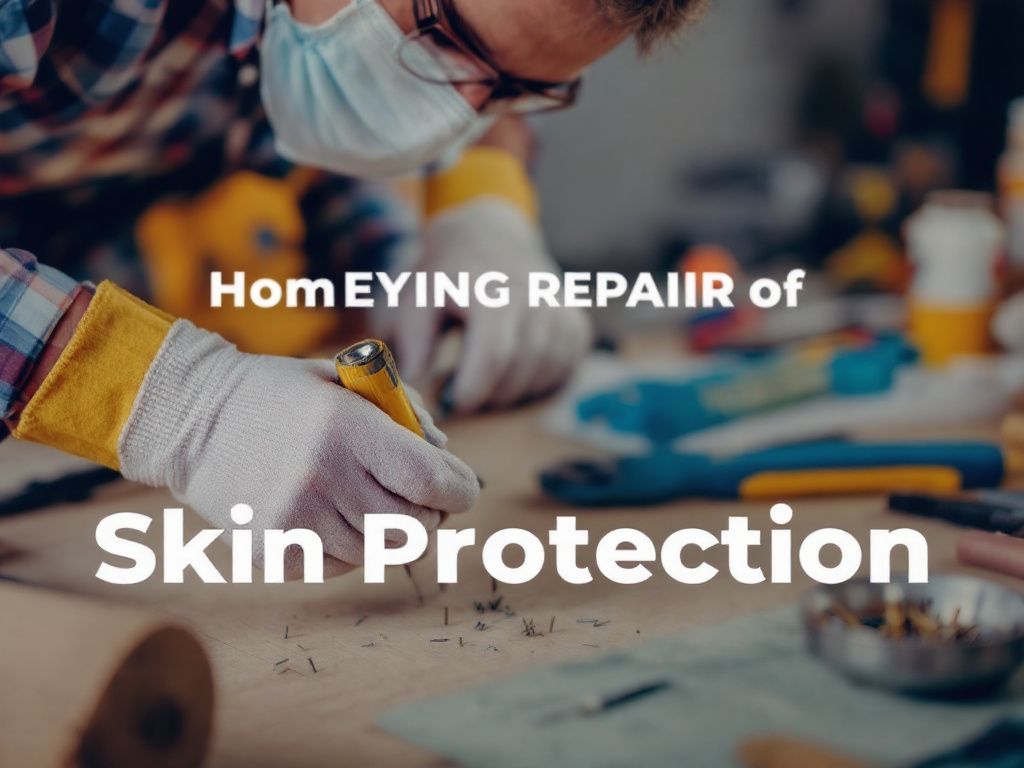Ever notice how your skin feels different after a day of DIY home repairs? It’s not just in your head. When you’re sanding, painting, or fixing, your skin is exposed to all sorts of elements it’s not used to dealing with—dust, debris, or even just long hours in the sun. That’s why focusing on skin protection is crucial when you’re diving into these projects.
Let’s dig into how you can keep your skin safe and sound while getting your hands dirty with those home repairs.
Understanding the Hazards: Why DIY Projects Affect Your Skin
Before diving into what to do, let’s talk about why DIY projects often lead to skin issues. Picture this: you’re standing in your recently gutted kitchen, surrounded by drywall dust, wood shavings, and a touch of possibly harsh chemicals like solvents or glues. Even if you’re gung-ho about getting things done, those elements can mess with your skin big time.
**The Culprits:**
- Dust Exposure: Constant contact with dust and debris can strip your skin of its natural oils, leading to dryness and irritation.
- Chemicals: Harsh substances you might be handling can cause everything from mild irritation to serious chemical burns if you’re not careful.
- UV Rays: Prolonged outdoor work in the sun without protection can lead to sunburn, an often-overlooked threat during home repairs.
Knowing what’s out there helps you defend against it. Armed with this knowledge, you’re more than halfway equipped.
Preparing for the Project: Essential Gear for Skin Protection
Just like you wouldn’t build a bookcase without a hammer, don’t step into your repair zone without the right skin protection gear.
Gloves: Your First Line of Defense
An absolute must-have. Opt for heavy-duty work gloves for tougher tasks and consider nitrile or vinyl if you’re working with chemicals. Throw them on whenever using tools, working with potentially hazardous materials, or simply handling rough surfaces.

Face Masks and Goggles
That fine particle dust magically appearing everywhere? Not great for your skin or respiratory system. Use face masks to keep dust at bay and goggles to avoid any stray splatters of liquid that could irritate your skin or eyes.
Sunscreen: Not Just For Beach Days
If you’re working outside or even just by a sunny window, apply broad-spectrum SPF before starting. Bonus: sunscreen also protects your skin from dust-induced dryness by offering a bit of a moisture barrier.
Protective Clothing
Long sleeves and pants in breathable fabrics guard skin against direct contact with scratchy surfaces and spills. Consider outfits that are work-specific and don’t matter to get messied up; they’ll save the day time and again.
Skin Protection Routine: Before, During, and After
Having your gear ready is half the battle. Keeping a routine for skin care throughout your repairs rounds out your robust defense plan.
Before You Dive In
Take a quick shower to remove any existing dirt and oils, applying a light moisturizer. Action plan? Use a non-greasy, fast-absorbing lotion so your grip isn’t compromised. Cover up with your gloves and protective clothing.
Materials You Might Need:
- Light, non-greasy moisturizer
- Broad-spectrum sunscreen
- Protective clothing
While You’re Deep in the Work
Keep a small towel or wet wipes nearby to clean hands periodically. Dry skin? Spritz a hydrating facial mist for a mid-day refresh. Also, have occasional water breaks—hydration from the inside matters more than you’d think.

As You Wrap Things Up
The end of your project isn’t the end of your skin protection routines. Thoroughly wash exposed skin areas to eliminate residual dust or chemicals. Apply a nourishing moisturizer post-cleaning to help restore the skin’s protective barrier and prevent dryness.
Pro Takeaway: Give this a try!
Store a small tub of shea butter near your workbench. This magical stuff is perfect for post-project relief and healing. Trust me on this one.
Recipe for a DIY Soothing Skin Balm
You absolutely can pick up pre-made skin products, but where’s the DIY fun in that? Creating your own soothing skin balm is surprisingly simple and gratifying. Here’s a quick recipe using things you might already have.
Ingredients:
- tablespoons coconut oil
- tablespoon shea butter
- tablespoon beeswax pellets
- Essential oil of your choice (lavender or chamomile are great for relaxing scents)
Instructions:
- Melt the coconut oil, shea butter, and beeswax together in a double boiler or a heat-resistant bowl placed over hot water.
- Remove from heat and stir in a few drops of essential oil.
- Pour into a clean, empty container and let it cool and solidify at room temperature.
- Apply a small amount to your hands after a work session.
It’s lovely for moisturizing after a day of engrossing do-it-yourself rigmarole. Plus, it’s so darn satisfying to use something you made yourself, isn’t it?
Overcoming Common Challenges: Quick Fixes and Pro Tips
Even seasoned DIY experts encounter hiccups now and again. Let’s talk about some common skin-related challenges and how best to breeze through them.

Dry, Cracked Hands
No team spirit with your hands feels like collaboration until they’re dry and cracked. Don’t fight it, prevent it. Frequent application of thick hand cream, particularly after washing, can fend off the worst of dry skin.
Spots or Rashes
Every so often, you might experience redness or an itchy rash. That’s your skin’s way of reminding you that maybe you forgot gloves or that mask. Cool baths with oatmeal or a soothing gel like aloe vera can work wonders for mild irritation.
Sore Muscles
Yeah, it’s not skin, but it’s a DIY staple: sore muscles drag you down. Light stretches at the end of the day and using your homemade balm act as solid recovery partners.
Creating A Past vs. Present Table for Skincare Evolution
Let’s take a moment for a little nostalgia and compare past and present skincare practices. Recognizing how far we’ve come can shed light on where we might still need improvements.
| Then (Past) | Now (Present) |
|---|---|
| Bar soap for all cleaning | Specific facial cleansers |
| No sunblock, sun-protective creams | Regular sunscreen usage |
| Hand lotions, creams rarely used | Daily moisturizing routine |
| Basic gloves sometimes an afterthought | Essential protective gear |
Seeing how our practices evolve helps motivate further simple but powerful upgrades.
Closing Thoughts: Own Your DIY Zone
By now, you should be feeling ready to dive into any home repair project with confidence, looking after your skin every step of the way. You’ve got the gear, prepped the right way, and know how to counteract common woes.
You’re free to tackle tasks without worrying about adverse skin reactions slowing you down. Keep your DIY zone safe, your household healthy, and let those creative repair vibes flow uninterrupted.
Always remember, the more you make self-care habitual, the more it integrates effortlessly into your daily life—even amidst the dust exposure and all the chaos of home repairs. Enjoy your time creating, building, fixing, and know your skin’s got you covered!
Frequently Asked Questions About Skin Protection
How Do I Determine My Skin Type for Effective Skin Protection?
To determine your skin type, you need to identify whether you have oily, dry, or combination skin. Oily skin is characterized by a shiny appearance and can be caused by stress, humidity, genetics, or hormones. Dry skin is often weather-induced and may appear red or flushed. Combination skin is a mix of both oily and dry skin. Knowing your skin type helps in selecting the right skincare products and routine[1][5).
What Skincare Routine Should I Follow for My Skin Type to Ensure Skin Protection?
For oily skin, use an oil-free and non-comedogenic cleanser, moisturize daily, and apply sunscreen. For dry skin, use a cleanser with hyaluronic acid, an alcohol-free toner, and a moisturizer to maintain hydration. For combination skin, balance products to address both oily and dry areas. Sunscreen is essential for all skin types to protect against sun damage[1][5).
How Often Should I Apply Sunscreen for Adequate Skin Protection?
Sunscreen should be applied every two hours, and more frequently if you have been swimming, sweating heavily, or drying off with a towel. Choose a broad-spectrum sunscreen with an SPF of at least 30 for daily activities and SPF 50 or higher for intense sun exposure. Apply sunscreen even on cloudy days as UV rays can penetrate through clouds[3).
Can I Use Sunscreen on Sensitive or Acne-Prone Skin Without Causing Irritation?
Yes, you can use sunscreen on sensitive or acne-prone skin by choosing non-comedogenic, oil-free, and lightweight formulas. These sunscreens are designed not to clog pores or irritate the skin. For acne-prone skin, products containing salicylic acid or benzoyl peroxide can also help manage acne while providing sun protection[1][3).
References










